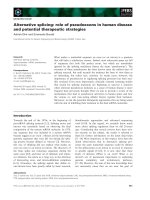Network Medicine- Complex Systems in Human Disease and Therapeutics
Bạn đang xem bản rút gọn của tài liệu. Xem và tải ngay bản đầy đủ của tài liệu tại đây (42.14 MB, 556 trang )
NETWORK MEDICINE
Complex Systems in Human Disease and Therapeutics
Edited By
JOSEPH LOSCALZO
ALBERT-LÁSZLÓ BARABÁSI
EDWIN K. SILVERMAN
Cambridge, Massachusetts
London, England
2017
Copyright © 2017 by the President and Fellows of Harvard College
All rights reserved
Cover image: Network map representing molecular relationships in a human cell © Mauro Martino
Cover deign: Annamarie McMahon Why
978-0-674-43653-4 (alk. paper)
978-0-674-54552-6 (EPUB)
978-0-674-54551-9 (MOBI)
The Library of Congress has cataloged the printed edition as follows:
Names: Loscalzo, Joseph, editor. | Barabási, Albert-László, editor. | Silverman, Edwin K., editor.
Title: Network medicine : complex systems in human disease and therapeutics / edited By Joseph Loscalzo, Albert-László
Barabási, Edwin K. Silverman.
Description: Cambridge, Massachusetts : Harvard University Press, 2016. | Includes index.
Identifiers: LCCN 2016006644
Subjects: LCSH: Medical informatics. | Data integration (Computer science) | Diseases—Causes and theories of causation—
Data processing. | Therapeutics—Data processing.
Classification: LCC R858 .N48 2016 | DDC 610.285—dc23
LC record available at />
We wish to dedicate this book to the students and teachers who have influenced our scientific paths and led us
to embark on this new journey
Contents
Preface
JOSEPH LOSCALZO, ALBERT -LÁSZLÓ BARABÁSI, and EDWIN K. SILVERM AN
1. Scientific Basis of Network Medicine
EDWIN K. SILVERM AN and JOSEPH LOSCALZO
2. Introduction to Network Analysis
JƯRG MENCHE and ALBERT -LÁSZLĨ BARABÁSI
3. Human Interactomes in Network Medicine
MICHAEL E. CUSICK, BENOIT CHARLOTEAUX, THOM AS ROLLAND, MICHAEL A. CALDERWOOD, DAVID E. HILL, and MARC
VIDAL
4. Social Networks in Human Disease
DOUGLAS A. LUKE and MARTIN W. SCHOEN
5. Phenotype, Pathophenotype, and Endo(patho)phenotype in Network Medicine
CALUM A. MACRAE
6. A New Paradigm for Defining Human Disease and Therapy
JOSEPH LOSCALZO
7. Complex Disease Genetics and Network Medicine
EDWIN K. SILVERM AN
8. Transcriptomics and Network Medicine
JOHN QUACKENBUSH and KIM BERLY GLASS
9. Post-translational Modifications of the Proteome: The Example of Tau in the Neuron and the Brain
GUY LIPPENS, JEREM Y GUNAWARDENA, ISABELLE LANDRIEU, CAROLINE SM ET -NOCCA, SUDHAKARAN PRABAKARAN,
BENJAM IN PARENT , ARNAUD LEROY, and ISABELLE HUVENT
10. Epigenetics and Network Medicine
DAWN L. DEMEO and SCOTT T. WEISS
11. Metabolomics and Network Medicine
JESSICA LASKY-SU and CLARY B. CLISH
12. Using Integrative -omics Approaches in Network Medicine
SHUYI MA, JOHN C. EARLS, JAM ES A. EDDY, and NATHAN D. PRICE
13. Cancer Network Medicine
TAKESHI HASE, SAM IK GHOSH, SUCHEENDRA K. PALANIAPPAN, and HIROAKI KITANO
14. Systems Pharmacology in Network Medicine
EDWIN K. SILVERM AN and JOSEPH LOSCALZO
15. Systems Approaches to Clinical Trials
ELLIOTT M. ANTM AN
16. Microbiomics in Network Medicine
JOANNE E. SORDILLO, GEORGE M. WEINSTOCK, and AUGUSTO A. LITONJUA
Abbreviations
Glossary
Contributors
Index
Preface
Mankind has sought rational explanations for the causes of illness since first recognizing symptoms of disease.
Early cultures attempted to account for disease as a consequence of an imbalance among internal humors or of
divine punishment for unacceptable behavior. With the advent of the formal disciplines of pathology and
histology, coupled with more rigorous assessment of phenotype, the era of clinicopathological correlation
began, linking, for the first time, objective abnormalities in tissue or organ function with disease syndromes.
By the middle of the previous century, the disciplines of physiology and biochemistry matured, phenotypes
became more quantitative, and the earliest molecular causes of disease were identified. All of these efforts,
however, followed a conventional reductionist approach to the discovery of the etiology of disease: It was
assumed that one or a very limited number of molecular abnormalities would be responsible for every
disease, no matter the complexity of the phenotype. In this era of modern genomics, big data, and quantitative
phenotypic complexity, we are now poised to think about the causes of disease in a truly integrative fashion.
No gene product exerts its effect on phenotype in isolation. Understanding the molecular context—the
integrated linkage diagram or network among all gene products in a cell—is essential for understanding the
true bases for phenotype and pathophenotype. This goal is the primary purpose of the newly defined field of
network medicine.
Representing the marriage of systems biology and network science, network medicine proposes a
disciplinary structure and investigative strategy that can be used to dissect the causes of all human diseases.
Network medicine embraces the complexity of multifactorial influences on disease, which can be driven by
nonlinear effects and molecular and statistical interactions. The development of comprehensive and affordable
-omics platforms provides the data types for network medicine, and graph theory and statistical physics
provide the theoretical framework to analyze networks. While network medicine offers a fundamentally
different approach toward understanding disease etiology, it will eventually lead to key differences in how
diseases are treated—with multiple molecular targets that may require manipulation in a coordinated, dynamic
fashion.
In this text, we and our contributing authors present the elements of network medicine, which include the
application of modern -omics technologies, network analysis, and dynamic systems analysis to complex
molecular networks within which genetic variants exist that alter the system’s behavior in an integrative
context. The multidisciplinary nature of network medicine research, which includes network science, systems
biology, molecular biology, biostatistics, and bioinformatics, creates important opportunities and challenges.
Even among experienced network science researchers, no single investigator can have complete mastery of
network methods, clinical phenotyping, molecular characterization, and bioinformatic approaches. Thus,
network medicine requires a team-based approach to medical research.
Our goals in this book are to provide an introduction to the major fields and network approaches to
complex diseases (Chapters 1 to 6), to provide more detailed reviews of progress in the analysis of specific omics data types using network-based approaches (Chapters 7 to 13), and to consider how network medicine
will influence disease treatment (Chapters 14 to 16). Readers interested only in specific topics may choose to
read relevant chapters selectively, but mastering the basic network concepts reviewed in Chapters 1 and 2
would greatly assist in understanding the subsequent chapters. We believe that network medicine, which will
ultimately redefine all of human disease and provide rational approaches to therapeutic development,
represents the true future of modern molecular medicine.
We hope that this book will be useful for medical researchers and quantitative scientists—both students at
the beginning of their careers and experienced investigators who are well established. We are particularly
hopeful that those at the beginning of their investigative careers will turn to network medicine as a way
forward in understanding complex diseases and that this book will help them in this journey. We also hope that
clinicians will find useful information here as well; although network medicine does not yet influence
treatment of most of the conditions discussed, it increasingly influences our understanding of disease
pathobiology. As progress continues, we expect that network medicine strategies will lead to new treatment
approaches and provide useful insights into treatment responses and adverse events.
As in any multi-authored book, the success of the endeavor relates to the commitment and creativity of the
collaborating authors; we are extremely thankful for the diligent and careful work of each of our contributors.
They represent an important resource as we enter the network medicine era. Many of the chapters in this book
evolved from the “Introduction to Network Medicine” course developed by Harvard Catalyst (The Harvard
Clinical and Translational Science Center). We would also like to thank our colleagues at Harvard University
Press, Michael Fisher and Janice Audet, who provided outstanding support for this project, and Stephanie
Tribuna and Justin Tribuna for expert editorial assistance. Finally, we wish to thank our families for their
patience and unwavering support during this project.
• 1 •
Scientific Basis of Network Medicine
EDWIN K. SILVERMAN AND JOSEPH LOSCALZO
Introduction
This chapter reviews the key concepts in molecular biology for readers without much background in biology
and includes an introduction to network science for readers without prior experience in systems biology.
Without an understanding of the terminology and basic principles in these fields, the remaining chapters of this
book will be difficult to follow. We will provide only an overview of basic principles, but we will cite
references to other sources for in-depth discussion of these topics.
Basic Principles of Molecular Biology
Overview of Molecular Biology
Living organisms are composed of multiple types of molecules that are organized in cells to perform specific
biological functions. Each multicellular organism comprises different cell types that are carefully placed
within organs and tissues during development. The fundamental instructions for each organism are encoded
within the sequence of their deoxyribonucleic acid (DNA), composed of four different types of nucleotides—
adenine, guanine, thymine, and cytosine—in eukaryotic organisms. DNA is a double helical structure, which,
in humans, includes a linear sequence of about 3 billion nucleotide bases. The DNA molecules are organized
into chromosomes (normal humans have 22 pairs of autosomal chromosomes and 2 sex chromosomes)
inherited from the parents after molecular recombination of parental chromosomes during the process of
meiosis. About 1% of the genome encodes the sequence for approximately 20,000 genes that specify proteins;
messenger ribonucleic acid (mRNA) is transcribed from the DNA of these protein-coding genes. The mRNA
is translated into proteins, composed of amino acids; proteins are the primary building blocks of cells. Thus,
the central dogma of molecular biology is: DNA is transcribed to RNA, and RNA is translated to protein
(Figure 1–1).
FIGURE 1–1. A simplified representation of key biological processes and related -omics data types. DNA is transcribed to
RNA, and mRNA is translated to proteins, which can then undergo post-translational modifications. Proteins can function as
enzymes to catalyze reactions between different types of metabolites; metabolites also serve as building blocks for other
key molecules in the cell. The -omics data types that can be extracted from these biological processes, including genetics,
epigenetics, transcriptomics, proteomics, and metabolomics, will be discussed in detail in subsequent chapters. SNP =
single-nucleotide polymorphism.
Not surprisingly, the molecular and cellular processes in biological systems are more complicated than the
central dogma may imply. Every cell of an organism inherits the same DNA sequence, and a network of
interacting factors determines whether that cell will differentiate into, for example, a lung epithelial cell or a
cardiac muscle cell, and whether the organ in which that cell resides will develop into a lung or a heart.
Epigenetic changes to the DNA sequence, such as the addition to or removal from cytosines of methyl groups,
can have profound effects on gene regulation. For transcription to occur, the DNA molecule, which is tightly
wound within the nucleus of the cell, needs to be unwound and bound by a group of molecules that compose
the transcriptional machinery. Post-translational modification of histone proteins (histone “marks”) can either
facilitate or impair access to the transcriptional machinery. These histone marks, DNA methylation, RNA
methylation, and noncoding, regulatory RNAs (vide infra) comprise the elements of epigenetic regulation, viz.,
determinants of phenotype that do not depend on the intrinsic genetic sequence of DNA itself. After the DNA
sequence of a gene has been transcribed into RNA, this primary RNA transcript is processed by splicing to
remove the noncoding intronic regions located between the protein-coding exons. For many genes, alternative
splicing can occur, with the selective exclusion of specific exons—resulting in distinct mRNA, and ultimately
protein, sequences derived from that gene. After translation of the mRNA into a primary amino acid sequence,
secondary structures such as sheets and helixes are formed, and the protein folds into a tertiary structure that
may become a subunit of a larger protein complex (quaternary structure). In addition, a variety of posttranslational modifications of protiens may occur, such as the addition of carbohydrate side chains or ubiquitin
molecules that can influence protein function and fate. Small molecules that can be building blocks for larger
biochemical structures (e.g., amino acids), sources of energy (e.g., sugars), or breakdown products are
referred to as metabolites. Biochemical reactions that produce or alter metabolites are often catalyzed by
enzymes, which are proteins with specific molecular functions.
The DNA sequences of different people are quite similar; common sites of genetic variation, which most
often involve single-base-pair differences in the DNA sequence (single-nucleotide polymorphisms, or SNPs),
occur on average only about once every 300 bases. Thus, there are about 10 million locations in the genome
that commonly vary between individuals. There are many more rare genetic variants, which often are unique
to an individual. If a genetic variant alters part of the DNA sequence that encodes an amino acid within a
protein, a different amino acid may be incorporated that may lead to altered biological functionality of that
variant protein. Genetic variants can also influence regions of the genome that regulate nearby or distant
genes. Krebs, Goldstein, et al. (2012), Lodish, Berk, et al. (2016), and Watson, Baker, et al. (2013) provide
excellent overviews of the basic principles of molecular biology.
Key Molecular Players in Gene Regulation
Even in the brief and simplified description of molecular biology provided above, it is clear that multiple
types of molecules must be coordinated in organized processes for living organisms to function. Some of the
coordinators of gene regulation include the key molecular participants in biological networks. For example,
transcription factors are proteins that bind to the DNA sequence and influence the transcription of other genes.
The binding locations can be upstream, downstream, or within coding regions, and those regulatory elements
fall into several major classes that influence gene expression. Enhancers increase gene expression, while
silencers reduce gene expression. Insulators function as enhancer-blockers or barriers that limit the effects of
enhancers or silencers (Raab and Kamakaka 2010).
Although only a small percentage of the DNA encodes exons within genes that include the protein-coding
sequence, much of the remaining DNA sequence shows a low level of transcription. The functional impact of
these noncoding genomic regions is largely unknown, but an important group of regulatory molecules are
noncoding RNAs. Noncoding RNAs include microRNAs and long-noncoding RNAs (lncRNAs), which have
important gene regulatory functions. In addition to gene regulatory networks, other key networks in molecular
biology include signal transduction networks, protein–protein interaction networks, and metabolic networks
(Junker 2008).
Overview of Major -omics Data Types
In order to identify a comprehensive set of interactions between genes and proteins, the development of largescale datasets that capture the biological activities of cells is essential (Figure 1–1). We will briefly discuss:
(1) transcriptomics—the gene expression signals in RNA; (2) proteomics—the protein components of a
biological sample; (3) metabolomics—the metabolites produced in biochemical reactions; and (4)
microbiomics—the microbiological (typically bacterial) components of an organ or other biological sample.
All of these -omics approaches require substantial bioinformatics support and sophisticated statistical
analyses.
Transcriptomics was made feasible by microarray assays that allowed detection of thousands of expressed
transcripts in one experiment. A probe attached to an array platform is used to interrogate selected types of
RNA. Typically, the various mRNA species are the focus of these assays, although microRNA and other RNA
types can also provide valuable information. Increasingly, transcriptomic studies are being performed with
sequencing of RNA (RNA-seq), which does not require capturing specific RNA transcripts in order to
perform quantitation (Guigo 2013).
Proteomic studies can provide complementary information to transcriptomics, since the correlation
between mRNA and protein levels within a cell or other biological sample is often surprisingly low. The
development of robust, high-throughput proteomic analysis has been technically challenging, but recently
developed mass spectrometric approaches, such as selected reaction monitoring (SRM), are promising tools
for quantitative proteomics assessment (Brusniak, Chu, et al. 2012). In addition to measurements of protein
levels, assessment of post-translational protein modifications can also be performed (Hein, Sharma, et al.
2013).
Metabolomic studies have been enabled by the recent development of reliable, high-throughput assay
systems for large panels of metabolites (Artati, Prehn, et al. 2012). Metabolomics can reflect many of the
cellular functional activities and provide information about dynamic changes, such as metabolite conversion
events known as “flux,” within a biological system. Other terms are used to describe analyses of specific
metabolite classes, such as “lipidomics,” which is the study of (small-molecule) lipids. Nontargeted,
comprehensive metabolomics typically involves quantitative assessments of a very large number of
metabolites, including unidentified analytes, while targeted metabolomics focuses on measuring a preselected
set of metabolites.
Microbiomics involves the assessment of the presence and/or abundance of various microorganisms within
a biological system of interest, such as the human intestine (Faust and Raes 2012). The identification of
bacterial species using 16S ribosomal sequencing or whole-genome sequencing has revolutionized this field,
since culturing and conventionally speciating the microorganism is no longer required. Determination of
microbial abundance is complex, as it requires accurate taxonomic identification of the nucleotide sequence
and appropriate statistical analysis to quantify the relative abundance of each taxonomic group.
Basic Principles of Network Science
Definitions of Key Network Terms
Excellent reviews of network science principles have been provided by others (Alon 2007; Schreiber 2008;
Steuer and Lopez 2008; Newman 2010; Yu, Huang, et al. 2011; Barzel, Sharma, et al. 2013; Barabasi 2016).
In this section, we will present some of the key terminology that will be used throughout this book. A more
detailed and theoretical discussion of network science principles is provided in Chapter 2.
Networks are composed of nodes (also known as vertexes) that are connected by edges (also known as
links) (Figure 1–2). Networks can be used to visualize and analyze a broad range of biological processes,
with nodes in the network representing a biological entity (e.g., gene, protein, or disease) and edges
representing the relationships and/or interactions between entities (e.g., physical interactions, transcriptional
activation, correlations in gene expression levels, or metabolic conversions by enzymes). Key nodes that
include multiple edges are often referred to as “hubs.” Graph theory is used to describe and analyze networks.
Edges can be undirected (indicating a connection or interaction between two nodes) or directed (indicating
a specific direction of the interaction between two nodes; typically represented with an arrow drawn from one
node to another). Edges can also be unweighted (in which an edge is placed if a threshold of evidence for a
connection or interaction is reached) or weighted (in which the strength of the interaction is indicated by the
weight [e.g., depicted by variable thickness] assigned to the edge). We will focus on simple networks in
which single edges connect different nodes, but edges connecting a node to itself (self-edges) or multiple
edges connecting two nodes can be included in more complex networks.
A network can be completely specified by the whole list of edges between nodes; such “edge lists” can be
used to improve computational efficiency (Schreiber 2008). However, a more typical network representation
is that of an “adjacency matrix,” in which both the rows and the columns of the matrix (each having a
dimension equal to the number of nodes) correspond to the nodes of the network. The adjacency matrix
includes values of 0 if an edge is not present between two nodes and a nonzero value (1 for a simple network)
if an edge is present in an unweighted network. When there are no self-edges, the diagonal elements of the
adjacency matrix are zero. The adjacency matrix of such a simple undirected network is symmetric (Figure 1–
2). For a weighted network, the adjacency matrix includes values based on the magnitude of the connection
weight. For a directed network, the adjacency matrix is asymmetric, conventionally assigning a value of 1 (in
an unweighted network) in the matrix location for an edge running from one node to another (Newman 2010).
FIGURE 1–2. A network with five nodes is shown at the top, and the corresponding adjacency matrix for this network is shown
on the bottom.
FIGURE 1–3. Some common network motifs are shown, including single-input, multiple-input, feed-forward loops, and feedback
loops. (Adapted from Yu, H., J. Huang, et al. (2011). Network analysis to interpret complex phenotypes. In: M. Dehmer, F.
Emmert-Streib, A. Graber, and A. Salvador, eds., Applied Statistics for Network Biology. Weinheim, Germany: Wiley-VCH, pp.
3–12.)
Network motifs are characteristic network patterns or subgraphs associated with specific biological
functions. Some common network motifs, shown in Figure 1–3, include: (1) single-input motifs—one node
regulates multiple other nodes; (2) multiple-input motifs—multiple nodes regulate multiple other nodes; (3)
feed-forward loops—multiple upstream nodes regulate a downstream node together; and (4) feedback loops
—a downstream node regulates an upstream node. More complex motifs can produce specific biological
responses. For example, oscillations in regulatory systems can be produced either by the combination of a
negative feedback loop from a gene regulated by a transcription factor in conjunction with positive
autoregulation by that transcription factor or by multiple repressors that negatively regulate each other in a
cycle (a “repressilator”) (Alon 2007). Larger, highly connected components of the network, which may be
composed of multiple motifs that perform a specific biological function, are referred to as “network
modules.”
Commonly Used Network Metrics
For a particular node in the network, the number of edges directly linked to that node is the “degree” of that
node. The frequencies of the degree values in the network constitute the “degree distribution” for the network,
which corresponds to the probability that a randomly selected node has a specific degree value (Figure 1–4).
The maximum number of edges within an entire simple network composed of n nodes is ½(n)(n − 1); the
density of the network is the fraction of these total possible edges that exist (Newman 2010). Many biological
networks have low density values and are referred to as “sparse.” Since the simple histogram approach for
assessing the nature of the degree distribution can be inaccurate for some networks, other approaches, such as
the use of the cumulative degree distribution, have been proposed (Steuer and Lopez 2008). For directed
networks, the number of inward-pointed edges to a node specifies the “in-degree” while the number of
outward-pointed edges from that node specifies the “out-degree.” Determining that a particular motif or
module is overrepresented within a network typically requires comparing it to randomly generated networks
with similar degree distributions. A variety of metrics have been used to identify the most important or central
node in a network; one of the most commonly used is “degree centrality,” which refers to the node with the
highest degree.









